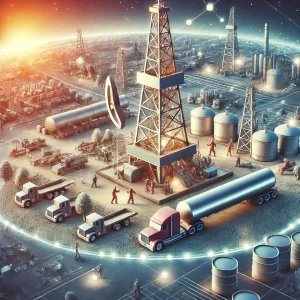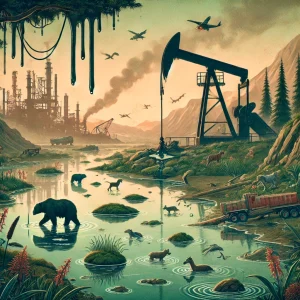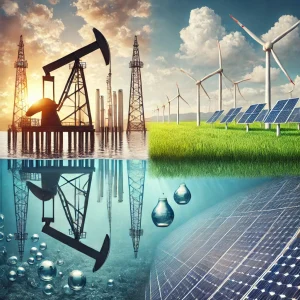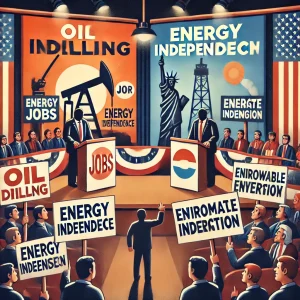Oil has been at the center of American energy policy for over a century. Often referred to as “black gold,” it has driven economic growth, powered industries, and kept the country moving. However, the extraction of oil through drilling on U.S. soil has also sparked a heated debate. Is drilling for oil a necessity for energy independence and economic stability, or is it an environmental gamble that could threaten the planet’s future? The answer is not simple, and the debate over drilling continues to divide policymakers, environmentalists, and energy experts alike.

🔷 The Economic Benefits of Oil Drilling
Oil is a vital part of the U.S. economy. The oil industry supports millions of jobs, from the engineers and workers on oil rigs to the truck drivers and refinery operators who ensure that oil reaches consumers. For decades, drilling for oil has helped keep gas prices low and has been a major driver of economic growth. In areas like Texas, North Dakota, and Alaska, where oil is plentiful, drilling has created boomtowns, boosting local economies and generating significant revenue.
Additionally, oil drilling helps the U.S. reduce its reliance on foreign oil, contributing to energy independence. By producing oil domestically, the U.S. can avoid being overly reliant on unstable foreign markets and maintain greater control over its energy security.

🔷 Environmental Risks of Oil Drilling
While the economic benefits of oil drilling are clear, the environmental risks are significant. Oil extraction and the infrastructure that supports it can have devastating effects on local ecosystems. Leaks and spills can contaminate water supplies, harm wildlife, and leave long-lasting damage on the environment. Moreover, drilling often disrupts sensitive habitats, displacing animals and plants.
Beyond immediate environmental damage, burning oil contributes significantly to climate change by releasing large amounts of carbon dioxide and other greenhouse gases into the atmosphere. Critics argue that continued reliance on oil threatens efforts to combat climate change and transition to renewable energy sources.
Let me generate an image reflecting the environmental risks associated with oil drilling, including scenes of spills and disrupted landscapes.

🔷 Balancing Energy Independence and Environmental Responsibility
One of the central arguments in favor of oil drilling is that it helps the U.S. maintain energy independence. By relying on domestic oil, the U.S. can reduce its dependency on foreign sources, which can be unpredictable or influenced by political instability. Proponents argue that drilling on U.S. soil allows the nation to control its own energy future and stabilize the economy.
However, environmentalists counter that energy independence should not come at the expense of the planet. They argue for investment in renewable energy sources like wind, solar, and geothermal power. These alternatives could reduce the need for oil while creating new jobs in clean energy sectors. The question remains: can the U.S. transition to renewable energy while still maintaining the economic stability that oil provides?
Let me generate an image showcasing the balance between oil drilling and renewable energy, with both types of energy production represented.
🔷 The Political and Public Debate
The debate over drilling on U.S. soil is not just an economic and environmental one—it is also deeply political. On one side, advocates for oil drilling emphasize job creation, lower energy costs, and national security. They argue that the U.S. should maximize its natural resources to remain competitive on the global stage.
On the other hand, environmentalists, scientists, and some policymakers stress the urgent need to address climate change. They argue that the continued extraction of fossil fuels is unsustainable and that a transition to clean energy is the only viable path forward for future generations. This debate plays out in Congress, state governments, and in public opinion, with divided perspectives on how to best balance economic and environmental priorities.
Let me generate an image that captures the political debate, showing two sides—one in favor of oil drilling and the other advocating for environmental protection.

🔷 Is There a Path Forward?
The debate over drilling for oil on U.S. soil isn’t likely to be resolved soon, but there are ways to move forward. Some suggest that the U.S. can strike a balance by continuing to drill for oil while investing heavily in renewable energy and minimizing environmental damage. Others believe that a complete shift away from fossil fuels is the only solution to the climate crisis.
Whatever the path forward may be, it is clear that the U.S. must make tough choices to ensure both economic stability and environmental sustainability. Finding that balance will be key to the country’s future energy policy.
Let me generate an image that symbolizes hope for a balanced and sustainable future, with both oil production and renewable energy coexisting in harmony.

Striking a Balance Between Black Gold and a Green Future
The debate over oil drilling on U.S. soil is complex, with strong arguments on both sides. Oil remains a crucial part of the U.S. economy and provides energy independence, but the environmental risks associated with drilling are significant. As the world confronts climate change, the challenge is finding a way to maintain economic growth while also transitioning to cleaner energy sources.
There may not be an easy answer, but one thing is clear: the future of energy in America will require a delicate balance between traditional oil extraction and renewable energy innovation. How the nation navigates this challenge will shape its environmental and economic landscape for generations to come.
Final Thoughts: Navigating the Future of Energy
The ongoing debate over oil drilling on U.S. soil is not just about choosing between economic growth and environmental protection—it’s about finding a path that balances both. As the nation seeks to secure energy independence and create jobs, it must also recognize the urgent need to address climate change and protect the environment. The stakes are high, and the decisions made today will have far-reaching consequences for future generations.
Ultimately, the solution may not lie in an all-or-nothing approach. By investing in renewable energy and adopting responsible drilling practices, the U.S. can work toward a future where economic stability and environmental sustainability go hand in hand. The challenge is significant, but so are the opportunities. If America can find a way to harmonize its energy needs with environmental responsibility, it could lead the world in creating a sustainable, prosperous future.


